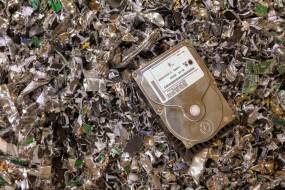Does degaussing work on solid-state drives (SSD)? This is a question you will likely ask yourself if you’re an SSD user that wants to permanently delete all data from your device. The short answer, unfortunately, is that degaussing does not work on SSD.
Here, we’ll explain the reasons why not and review 2 alternatives for drive sanitization: data wiping and storage media destruction.

What Is Degaussing?
Degaussing is a method of physically destroying data that works by eliminating magnetic fields. This technique is possible due to the magnetic domains that storage devices like hard drives use to record information. By neutralizing these magnetic domains, degaussing is able to permanently destroy the data that is stored on hard drives and compatible devices.
Why Does Degaussing Not Work on SSD?
The most obvious limitation of degaussing is that it only works on devices that store data magnetically. This means that the technique is ineffective on solid-state drives, as SSDs store data by using flash memory chips instead of magnetic domains. Other types of flash-based storage devices, such as USB drives and memory cards, are also unaffected by degaussing.
Users of traditional hard drives should also consider alternative methods to degaussing for permanent data removal. In addition to being an expensive option, degaussing is a solution that destroys the basic function of magnetic storage devices, which renders the drives unusable. From an environmental or sustainability perspective, this can be hard to justify.
What Are the Alternatives to Degaussing?
With the limitations of degaussing in mind, let’s take a look at 2 alternatives ways of deleting all data from SSDs and traditional hard drives: data wiping and storage media destruction.
#1: Data Wiping
Data wiping is a software-based solution that removes the content of disk space beyond recovery. To ensure that deleted data cannot be recovered, the process of data wiping removes all traces of residual data (also known as data remanence).
Pros
- Securely removes data from traditional hard drives, SSDs and NVMe drives, ensuring that information is unrecoverable by third parties
- Data wiping is a verifiable process that ensures all data has been correctly overwritten by creating wiping reports to comply with GDPR and LGPD
- Users have the option to wipe the entire drive or target selected files
- Drives can be reused, sold or donated after wiping
- A more sustainable option that reduces harmful electronic waste
Cons
- Data wiping is likely a paid solution
- Basic technical skills may be required to use the software, although most solutions are user-friendly
To start securely erasing your hard drive, take a look at how you can do it in 5 easy steps with BCWipe.
#2: Storage Media Destruction
Storage media destruction is a method of preventing information from being recovered by physically destroying the data storage device. There are many physical techniques for destroying data, such as disintegrating, shredding, and burning. For many people that choose this option, the destruction of data can be achieved by using a hammer or other household tool.
Pros
- Storage media destruction works on both traditional hard drives and SSDs
- Data cannot be recovered by third parties if storage devices are properly destroyed
- Some methods of storage media destruction can provide a cost-free solution
Cons
- If storage devices are not destroyed correctly then data can still be recovered
- Storage media destruction doesn’t allow you to verify whether data was destroyed correctly or not, which can be a compliance problem
- Drives and storage devices cannot be reused
- Unsustainable and environmentally unfriendly while creating harmful electronic waste
For more information on the benefits of wiping and repurposing your storage device, here’s 3 reasons why you should not destroy your hard drive.
Since we now understand that degaussing does not work on SSD, you can choose between data wiping and storage media destruction to permanently delete all data from your device. Review our 5-step checklist for hardware decommissioning to get started.
Related Articles
Data Sanitization 5 Common Myths
Hardware Decommissioning Process: A 5-Step Checklist
The Ultimate Guide to Deleting Files Permanently
IRS Publication 4812 & How to Comply with Wiping Standards
DoD 5220.22-M Explained – Data Erasure Standards
NIST SP 800-88 Guidelines for Media Sanitization Explained
IEEE 2883-2022 Standard for Sanitizing Storage
How to Delete Files on SSD
How to Wipe an NVMe Drive
How to Wipe an SSD on Windows 11 & 10
How to Wipe a Hard Drive on a Dead Computer
